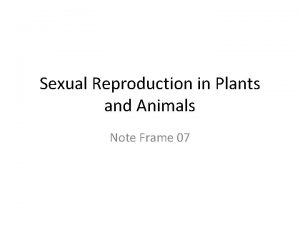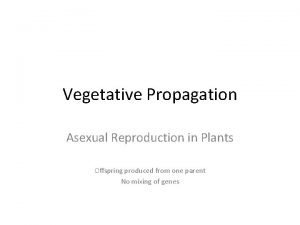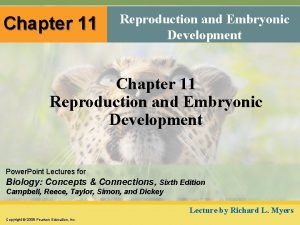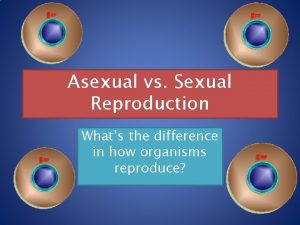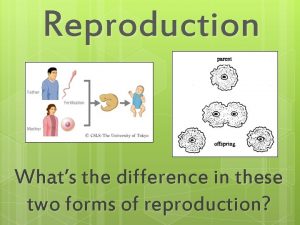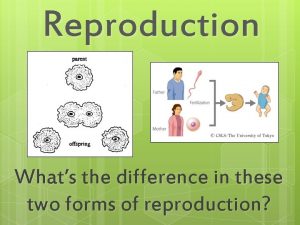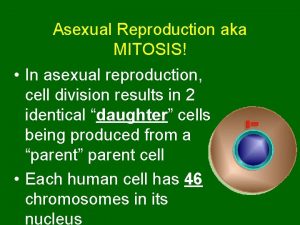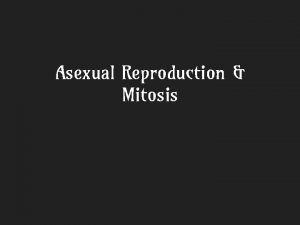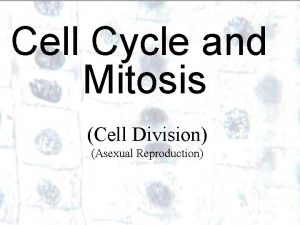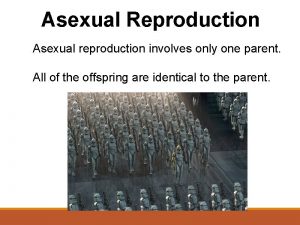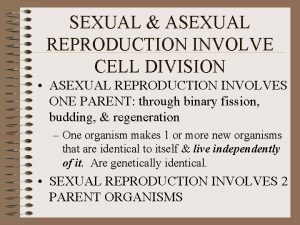Reproduction and the Cell Cycle Asexual Mitosis Only























- Slides: 23

Reproduction and the Cell Cycle • Asexual – Mitosis – Only 1 parent – Offspring genetically identical to parent p 1 • Sexual – Meiosis – 2 parents – Offspring have ½ of each parent’s DNA – Offspring have more genetic variation

Why must cells divide? Once a cell reaches a certain size, it is no longer efficient to try to keep nutrients, water and waste going in the right direction. Think about it. Would it be easier to manage a large city like New York or a smaller one like Archdale?

Cells can be different sizes but most are small. Why? • As a cell’s size increases, its surface area to volume ratio decreases. This makes it more difficult for cell processes like transport of substances in and out of the cell. Side length Surface Area Volume Surface Area/ Volume Ratio 1 mm 6 mm 2 1 mm 3 6: 1 2 mm 24 mm 2 8 mm 3 3: 1 3 mm 54 mm 2 27 mm 3 2: 1


Some cells divide simply to reproduce. Binary Fission occurs in bacteria. This is a form of asexual reproduction, when there is only one parent. p 2

Cell Cycle in Eukaryotes The Cell Cycle Ends With Reproduction.

Interphase Video below The cell spends most of its time in this stage when it grows, develops and replicates its DNA in preparation for cell division. p 3

Mitosis After interphase, the cell can go in one of two directions. Mitosis is nuclear division which leads to cellular division. The daughter (new) cells have the same number of chromosomes as the parent (old) cell. This is the diploid number. This occurs in body cells through growth and regeneration of multicellular organisms. p 4

It is also a reproduction method for asexually reproducing organisms. The hydra to the left is budding; a new hydra is protruding from his body and will fall off. p 4

Yeast budding:

Vegetative propagation is the appearance of new plants without the use of seeds or spores. A cutting of a Mulberry tree is pictured on the left. It will sprout roots and can be planted soon. Runners are new strawberry plants that sprouted from the original on p 4 the right.

Parthenogenesis is a form of reproduction in which the ovum develops into a new individual without fertilization The whiptail lizard in the center is a species in which there are only females. p 4

The stages of Mitosis are as follows: Prophase Metaphase Anaphase Telophase Remember: Phone Me Any Time!!

centrioles Prophase Spindle fiber During propahse, the centrioles and spindle fibers become visible. The nuclear envelope disappears and the chromatin condenses into chromosomes. p 5

Metaphase Here, notice that the centrioles are at opposite poles. The spindle fibers are attached to the centrioles on one side and the centromere on the other lining up in single file along the “equator” of the cell in preparation for a division of the chromosomes. p 6

Anaphase This is the stage in which the spindle fibers contract like a muscle. In doing so, they rip the centromere in half, pulling chromatids to opposite sides of the cell. p 7

Telophase This final stage of mitosis is where we see a nuclear envelope reappear. Also the spindle fibers disappear. This is essentially the opposite of prophase. p 8

Cytokinesis This is the final stage in cell division in which the cytoplasm is divided among the 2 daughter cells and the membrane is pinched in half along a cleavage furrow. Both daughter cells each have 1 complete copy of the p 9 DNA.

Video Quiz

Put it all into motion and it looks like this.

Mitosis occurs in your epithelial (skin) cells at a rapid rate. • You lose millions of skin cells each day as mitosis replaces them with fresh, new cells.

Some cells no longer go through mitosis. • You are born with all the muscle and brain cells that you will ever have so take care of them!!

http: //kvhs. nbed. nb. ca/gallant/biology. html http: //www. anselm. edu/homepage/jpitocch/genbio/binfission. JPG http: //science. gulfcoast. edu/lindafitzhugh/BSC%201005/Mitosis%20 and%20 Meiosis%20 review. htm www. karlloren. com/biopsy/p 66. htm http: //www. troy. k 12. ny. us/thsbiology/skinny_mitosis. html http: //www. microscope-microscope. org/microscope-images. htm http: //www. bio. mtu. edu/~jkoyadom/algae_webpage/PROTOZOAN_IMAGES/rhizopoda/Ameoba_s 25_swedetownplant 2 a_402. jpg The Complete Far Side, Volume 2
 Asexualk
Asexualk The disadvantages of sexual reproduction
The disadvantages of sexual reproduction Venn diagram asexual vs sexual reproduction
Venn diagram asexual vs sexual reproduction Mitosis sexual reproduction
Mitosis sexual reproduction Types of asexual reproduction and examples
Types of asexual reproduction and examples Two types of reproduction
Two types of reproduction Animal chromosome number
Animal chromosome number Venn diagram asexual and sexual reproduction
Venn diagram asexual and sexual reproduction Sexual example
Sexual example Where does cactus store water
Where does cactus store water Parthenogenesis
Parthenogenesis Mitosis and cell cycle terminology
Mitosis and cell cycle terminology Mitosis/meiosis concept map answers
Mitosis/meiosis concept map answers Dahlia asexual reproduction
Dahlia asexual reproduction Types of asexual reproduction
Types of asexual reproduction Segmentation of nematoda
Segmentation of nematoda Layering asexual reproduction
Layering asexual reproduction Type of sexual reproduction
Type of sexual reproduction Asexual reproduction
Asexual reproduction Gastrula
Gastrula Whats sexual reproduction
Whats sexual reproduction Chapter 19 asexual reproduction
Chapter 19 asexual reproduction Whats sexual reproduction
Whats sexual reproduction Whats reproduction
Whats reproduction









